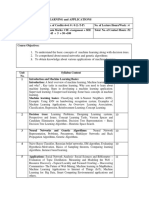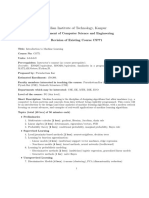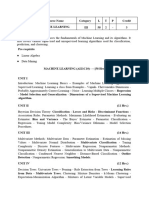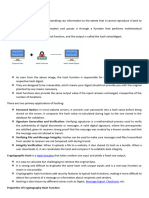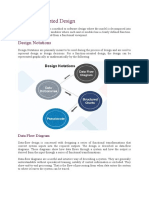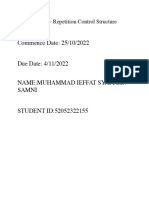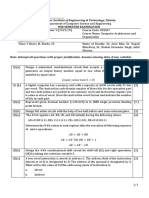ML with python Syllabus
Uploaded by
dg107835ML with python Syllabus
Uploaded by
dg107835Course Curriculum (w.e.f.
Session 2021-22)
B.Tech. in Computer Science & Engineering (Honors)
BCSC 0075: MACHINE LEARNING USING PYTHON
Objective: To introduce students to the basic concepts and techniques of Machine Learning. To develop
skills of using recent machine learning software for solving practical problems. To gain experience of doing
independent study and research.
Credits: 02 L–T–P-J: 2–0–0-0
Module Theory
Content
No. Hours
Introduction to Machine Learning Introduction to Machine Learning and
applications of Machine Learning in different fields such as health care, banking,
telecommunication, Python for Machine Learning, Supervised vs Unsupervised.
Regression: Introduction to Regression, Simple Linear Regression, Evaluation
Metrics in Regression Models, Multiple Linear Regression, Polynomial
Regression. Application of Linear Regression and Multiple Linear Regression on
different real life datasets.
I 15
Classification: Introduction to Classification, Intro to Logistic Regression,
Logistic regression vs Linear regression, Logistic Regression Training, K-Nearest
Neighbors, Evaluation Metrics in Classification, Introduction to Decision Trees,
Building Decision Trees using ID3 algorithm. Support Vector Machine, Multiclass
Classification. Application of SVM (Support Vector Machines) to classify human
cells as benign or malignant.
Clustering: Intro to Clustering, k-Means clustering, apply k-means clustering for
customer segmentation.
Artificial Neural Networks: Introduction to Neural network, Gradient Descent
Algorithm, Back-propagation, Vanishing Gradient, Activation Functions.
II Deep Learning: Introduction to Deep Learning, Shallow Versus Deep Neural 15
Networks, Convolutional Neural Networks, Padding, Strided Convolutions,
Pooling Layers, Fully Connected layer, Flattening, Building Blocks of Deep Neural
Networks. Apply Convolutional Neural Network (CNN) for classifying
handwritten digits using MNIST dataset.
Text Book:
• Tom M. Mitchell, “Machine Learning”. Tata McGraw-Hill Education, 2013.
• Alpaydin, E. , “ Introduction to machine learning”. MIT press, 2009.
• Ian Goodfellow and Yoshua Bengio and Aaron Courville, “Deep Learning”, MIT Press, 2016.
Reference Books:
• Harrington, P.” Machine learning in action”. Shelter Islan”, NY: Manning Publications Co, 2012.
• Bishop, C. M., “Pattern recognition and machine learning (information science and statistics)”
springer-verlag new york. Inc. Secaucus, NJ, USA, 2006.
• Charu C. Aggarwal, “Neural Networks and Deep Learning”, Springer International Publishing, 2018.
Outcome: After completion of Lab, student will be able to:
• CO1: Apply the basic concepts of machine learning.
• CO2: Analyze the concepts of regression and classification methods.
DEPARTMENT OF COMPUTER ENGINEERING & APPLICATIONS, Institute of Engineering & Technology
Course Curriculum (w.e.f. Session 2021-22)
B.Tech. in Computer Science & Engineering (Honors)
• CO3: Design unsupervised learning based solutions.
• CO4: Analyze the concepts of artificial neural network methods.
• CO5: Identify the ways of feature extraction, reduction and selection.
• CO6: Design the applications of machine learning algorithms.
Mapping of Course Outcomes (COs) with Program Outcomes (POs) and Program Specific
Outcomes (PSOs):
COs POs/PSOs
CO1 PO1, PO2/PSO3, PSO4
CO2 PO1, PO2/PSO1, PSO3
CO3 PO1, PO3, PO5/PSO1, PSO3
CO4 PO1 /PSO1
CO5 PO2/PSO3
CO6 PO1, PO2, PO3/PSO1, PSO2, PSO4
DEPARTMENT OF COMPUTER ENGINEERING & APPLICATIONS, Institute of Engineering & Technology
You might also like
- 2023 Scheme BE AI 3rd Year CBS Syllabus TENTATIVE MinNo ratings yet2023 Scheme BE AI 3rd Year CBS Syllabus TENTATIVE Min158 pages
- Indianinstitute of Information Technology Design and Manufacturing (Iiitd&M) KancheepuramNo ratings yetIndianinstitute of Information Technology Design and Manufacturing (Iiitd&M) Kancheepuram1 page
- R18B Tech MinorIVYearISemesterTENTATIVESyllabusNo ratings yetR18B Tech MinorIVYearISemesterTENTATIVESyllabus22 pages
- 202046702 Artificial Intelligence and Machine LearningNo ratings yet202046702 Artificial Intelligence and Machine Learning4 pages
- National Institute of Technology Patna: Department of Computer Science & EngineeringNo ratings yetNational Institute of Technology Patna: Department of Computer Science & Engineering2 pages
- AML - Theory - Syllabus - Chandigarh UniversityNo ratings yetAML - Theory - Syllabus - Chandigarh University4 pages
- Course Syllabus - Spring Semester 2022/2023 DS 14350 Computer Architecture For Machine LearningNo ratings yetCourse Syllabus - Spring Semester 2022/2023 DS 14350 Computer Architecture For Machine Learning3 pages
- Final PRINT 2022 SCHEME VI SEM SCHEME & SYLLABUSNo ratings yetFinal PRINT 2022 SCHEME VI SEM SCHEME & SYLLABUS30 pages
- 3P Machine Learning IAC VI Sem BTECH CSE LabNo ratings yet3P Machine Learning IAC VI Sem BTECH CSE Lab2 pages
- Course Code Course Title Course Planner: Through This Course Students Should Be Able ToNo ratings yetCourse Code Course Title Course Planner: Through This Course Students Should Be Able To4 pages
- Machine Learning and Applications: AssignmentNo ratings yetMachine Learning and Applications: Assignment2 pages
- CE0733_Machine Learning and Deep Learning_CompulsoryNo ratings yetCE0733_Machine Learning and Deep Learning_Compulsory3 pages
- Indian Institute of Technology, Kanpur: Department of Computer Science and Engineering Revision of Existing Course CS771No ratings yetIndian Institute of Technology, Kanpur: Department of Computer Science and Engineering Revision of Existing Course CS7712 pages
- M.tech ML&C - Curriculum - Revision From 2018No ratings yetM.tech ML&C - Curriculum - Revision From 201813 pages
- Artificial Intelligence & Machine Learning1No ratings yetArtificial Intelligence & Machine Learning13 pages
- III B.Tech I Sem MachineLearning (20AD5T04)No ratings yetIII B.Tech I Sem MachineLearning (20AD5T04)1 page
- AML - Lab - Syllabus - Chandigarh UniversityNo ratings yetAML - Lab - Syllabus - Chandigarh University9 pages
- AI for Everyone: An Intermediate Guide to Artificial IntelligenceFrom EverandAI for Everyone: An Intermediate Guide to Artificial IntelligenceNo ratings yet
- Django School Management Report and Documentation (1) - 1No ratings yetDjango School Management Report and Documentation (1) - 153 pages
- OPERATING - SYSTEM - IV & V PYQs & SOLUTIONNo ratings yetOPERATING - SYSTEM - IV & V PYQs & SOLUTION30 pages
- final consolidated 24CSP29 Python Programming laboratory programs (1)No ratings yetfinal consolidated 24CSP29 Python Programming laboratory programs (1)12 pages
- Thapar Institute of Engineering & Technology, Patiala: Mid Semester ExaminationNo ratings yetThapar Institute of Engineering & Technology, Patiala: Mid Semester Examination2 pages
- HTTPWWW - Satiengg.intenderfrm Download File - Aspxfilepath PDFIoT20II20Semster20Syllabus20202022191222045332 PDFNo ratings yetHTTPWWW - Satiengg.intenderfrm Download File - Aspxfilepath PDFIoT20II20Semster20Syllabus20202022191222045332 PDF14 pages
- VTU Exam Question Paper With Solution of 18MCA51 Programming Using C#.NET Jan-2021-Ms Uma BNo ratings yetVTU Exam Question Paper With Solution of 18MCA51 Programming Using C#.NET Jan-2021-Ms Uma B37 pages
- Introduction To: Formal Language TheoryNo ratings yetIntroduction To: Formal Language Theory28 pages
- Sequential Logic Design Practices: 5.1 Sequential Circuit Documentation StandardsNo ratings yetSequential Logic Design Practices: 5.1 Sequential Circuit Documentation Standards12 pages






















